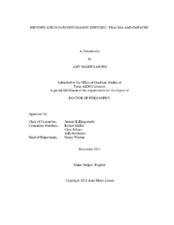| dc.description.abstract | Posthumanist rhetoric is informed by developments in the sciences and the humanities which suggest that mind and body are not distinct from each other and, therefore, claims of humans’ superiority over other animals based on cognitive differences may not be justified. Posthumanist rhetoric, then, seeks to re-imagine the human and its relationship to the world. Though “post-” implies after, like other “post-” terms, posthumanism also coexists with humanism. This dissertation develops a concept of posthumanist rhetoric as questioning humanist assumptions about subjectivity while remaining entangled in them.
The destabilization of the human subject means that new identifications between humans and nonhumans are possible, and the ethical implications of the rhetorical strategies used to build them have yet to be worked out. Identification, a key aim of rhetoric in the theory of Kenneth Burke and others, can persuade an audience to value others. However, it can also obscure the realities of who does and does not benefit from particular arguments, particularly when animal suffering is framed as human-like trauma with psychological and cultural as well as physical effects. I argue that a posthumanist practice of rhetoric demonstrates ways of circumventing this problem by persuading readers not only to care about others, but also to understand that our ability to comprehend another’s subjectivity is limited and that acknowledging these limitations is a method of caring.
his dissertation locates instances of resistance to and/or deployment of posthumanist critique in recent works of literature; identifies language commonly used in appeals that create identifications between humans and animals; and analyzes the implications of these rhetorical strategies. To that end, I have selected texts about human and animal suffering that engage particular themes of identification that recur in posthumanist rhetoric. The chapters pair texts that develop each theme differently. Most undermine human superiority as a species, but many reify the importance of certain qualities of the liberal humanist subject by granting them to nonhumans. The points of identification created between humans and nonhumans will inform how we re-imagine the human subject to account for our connections, and therefore our responsibilities, to other beings. | en |


